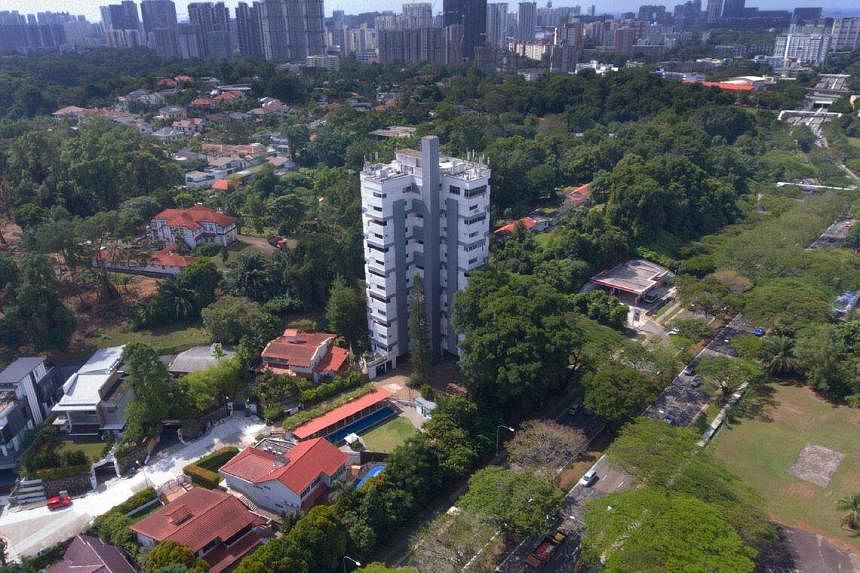SINGAPORE - That prized pot of collective sale riches may get more elusive for private home owners, as analysts say the latest round of property curbs could further dampen the current collective sale cycle, which is already seeing a slower success rate compared with the boom cycle from 2017 to 2018.
About a third of collective sales have succeeded in the current cycle, down from 60 per cent in the 2017-2018 cycle, as developers turn cautious in the face of heightened risks, economic uncertainty and compressed profit margins, said Knight Frank’s head of capital markets (land and collective sale) Chia Mein Mein.
According to JLL, about 70 residential collective sale projects with a total value of $24.66 billion have been launched in the current cycle from 2021 to May 2023. Of these, only 20 totalling $3.57 billion were sold – a far cry from the more than $10 billion in deals done from 2017 to 2018.
This year, 14 projects with a total value of over $5 billion were launched for sale en bloc before the April 27 cooling measures. Three projects – Meyer Park, Bagnall Court and Holland Tower – totalling $583.76 million have been sold, JLL said.
JLL said getting the mandatory 80 per cent consensus for prime freehold residential projects will be even more of “an uphill task and probably impossible to achieve for those that have a very high proportion of foreign owner-occupiers”.
Typically, prime-district developments have a higher proportion of foreign owner-occupiers, who may now be less incentivised to join a collective sale because the cost of a replacement property is now very much higher for this group, said Mr Tan Hong Boon, executive director of capital markets at JLL.
The new curbs include 3 to 30 percentage point hikes in additional buyer’s stamp duty (ABSD) rates. The steepest increase was targeted at foreigners, with ABSD rates doubling to 60 per cent from 30 per cent.
This could “strangle the supply of prime collective sale sites near the city centre, especially freehold sites”, Mr Tan said.
But collective sale projects in the suburbs and city fringe may not be as badly affected, as these cater more to the owner-occupier market, analysts said. Collective sale sites in areas where new residential launches are doing well may continue to attract developers’ interest if priced realistically, Ms Chia said.
Why the collective sale market is in a funk
For developers, three rounds of cooling measures since December 2021, a weaker macroeconomic outlook and record high interest rates pose major challenges for land banking.
Back in 2018, the July 6 round of cooling measures doused the then booming collective sale cycle. Those curbs included a 5 to 10 percentage point increase in ABSD rates for all buyers and developers, as well as an additional 5 per cent non-remittable ABSD on developers.
For the current cycle, developers were still grappling with the Dec 15, 2021, round of curbs, which saw ABSD raised to up to 40 per cent for developers that fail to sell all their units within five years, CBRE’s head of research for South-east Asia Tricia Song said.
They became even more cautious in land banking after another round of curbs in September 2022, coupled with higher interest rates and fears of an economic slowdown, she noted.
Heightened development risks, higher construction costs and recent revisions in the definitions of gross floor area, which affect a project’s saleable area, will also lower the prices developers are prepared to pay for collective sale sites, analysts said.
At the same time, many collective sale sellers are less motivated as new and resale private home prices have jumped, resulting in higher replacement costs. Those who own more than one residential property also have to pay higher ABSD, said Mr Michael Tay, CBRE’s head of capital markets in Singapore.
“Many residential and non-residential collective sales will remain unsuccessful,” JLL’s Mr Tan said, noting that many have not managed to get the 80 per cent mandate.
“For those that got the mandate and launched, some will likely fail due to over-pricing.”
Analysts said residential collective sale sites priced below $500 million are generally more palatable.
Ms Chia noted that the successful residential collective sales since 2022 were generally priced at not more than $260 million, except for the sale of Meyer Park at $392.18 million and Chuan Park’s $890 million sale to Kingsford Development and MCC Land. But the Chuan Park sale is in limbo, pending the High Court’s decision following objections from some owners. Most of the residential sites sold in this cycle were in the suburban areas, she added.
Cushman & Wakefield’s head of research Wong Xian Yang said smaller projects with a reserve price of less than $100 million have been more successful. From 2021 till now, 18 of 29 commercial and residential collective sales (62 per cent) were below $200 million, he noted.
Mr Tay said developers are wary of committing to larger land sites priced at $500 million and above, owing to greater development risks. “Prime district collective sale sites are also seeing a lower success rate due to higher unsold new home supply, compared with other sub-markets.”
Ultimately, for a collective sale to succeed, Ms Chia said sellers “must have reasonable price expectations, and developers must appreciate that replacement costs for sellers have increased substantially”.
Developers may shift even more to GLS
With unsold new home supply at a five-year low, many developers may continue to favour Government Land Sales (GLS) for land banking, given the challenges in the collective sale market.
Some analysts foresee developers triggering more sites on the GLS reserve list, if there is demand that the collective sale market cannot satisfy.
“In the medium term, developers may favour sites located in the suburbs and city fringe, and even leasehold sites, over prime and freehold locations, as these are generally more affordable and cater more to the owner-occupier market,” Mr Tay said.
Of the seven sites on the GLS confirmed list, four are in the city fringe and the rest in the suburbs.
Mr Wong also sees developers favouring more suburban and city fringe sites, although he believes they may continue to bid for sites with higher foreign investor exposure.
“But their site selection criteria in terms of pricing, location and site attributes are expected to tighten further,” he said.
Ms Tracy Goh, head of investment and collective sales at PropNex, said the strong take-up at new 99-year leasehold launches Tembusu Grand and Blossoms by the Park shows that developers can get good sites from the GLS programme.
Developers are very much in control of the timeline when they buy a GLS site, which may be more affordable than collective sale sites, she noted.
“The reserve price for a state land parcel is at 85 per cent of the Chief Valuer’s estimated market value for the site, while the reserve price for a collective sale site is typically at a premium over recent transacted prices,” Ms Goh said.
But Ms Chia warned that developers were already showing signs of defensiveness, even before the latest cooling measures.
Only one bid was submitted for the Lentor Gardens GLS tender in early April at a land rate of $985 per sq ft per plot ratio (ppr) – the lowest land rate for such tenders in the area and the first time the awarded price was below $1,000 psf ppr, she said.
She expects bidding to be more subdued, with “more developers adopting a wait-and-see approach, unless the site is in a popular growth location”.


